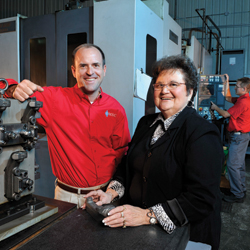
A new generation of employees is finding success with an old process dating back to World War II.
Skills gap. Worker shortage. Shrinking labor force. Whatever you call it, it’s no surprise to anyone leading a business today that finding properly educated and trained employees can be a struggle. What is unexpected is the solution many of those business leaders are implementing with great success. Called Training Within Industry (TWI), it dates back to the start of World War II—when thousands of “Rosie the Riveters” were taking their places in American factories.
“Just as new people were entering the workforce for the first time in World War II, new workers are joining manufacturers today without any past job experience,” says Ed Huey of the Illinois Manufacturing Excellence Center (IMEC), which works with manufacturers throughout the state to implement TWI. “Helping them become fully productive in a short time is still the goal, and TWI is a time-tested process that works across industries, across vocations and in union and non-union environments.”
TWI got its start in the 1940s as a way to boost U.S. industrial production in support of the war effort. The program focused on creating work environments where jobs were performed the same way by all team members and problem-solving occurred at the operator level. By any measure, it was a great success: All the companies that implemented TWI during World War II reported a reduction in training time and grievances by at least 25 percent, with 86 percent increasing production by at least 25 percent and 55 percent reducing scrap by at least 25 percent.
Despite the program’s success, most American manufacturers turned their focus elsewhere after the war, and TWI found a home in Japan instead. That country’s business leaders used its principles to rebuild their industrial base and eventually implement the world’s first lean manufacturing system, the Toyota Production System. An integral element of Kaizen, continuous improvement and standard work, TWI is still in widespread use throughout Japan.
Now, 70-plus years after Rosie the Riveter entered the workforce, a new generation of U.S. employees is finding success with TWI’s hands-on, participatory style and standardized modules that provide the essential skills needed by supervisors, team leaders and anyone who indirectly leads others. Steve Barnhart, IMEC service manager and TWI specialist, has seen the benefits firsthand—including increased productivity from new and existing employees alike, fewer quality issues, lower turnover and improved safety.
“Supervisors become more confident and therefore much more proactive rather than reactive,” he says. “Manufacturing processes become more lean, because the methodology helps supervisors and employees see and eliminate waste.” iBi

